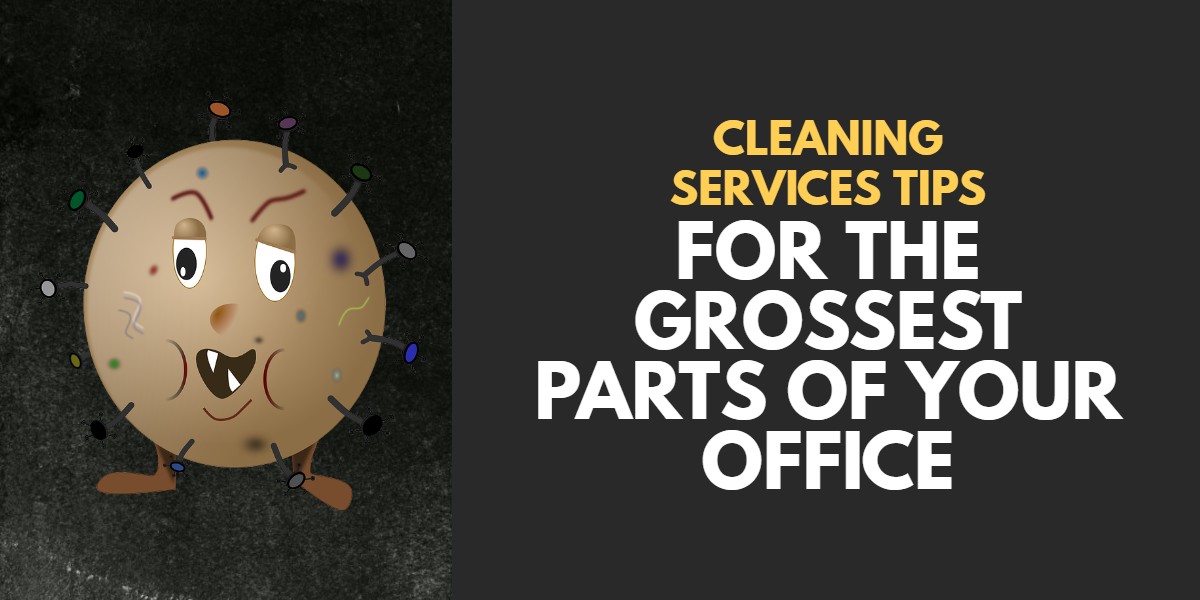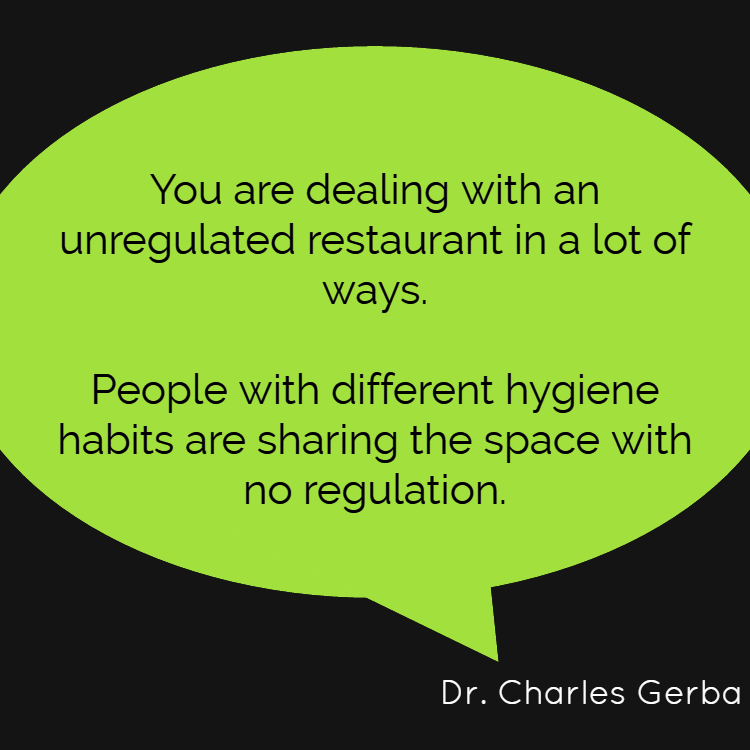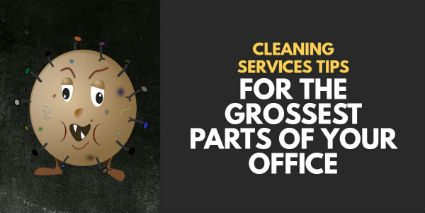Check out our latest cleaning services tips to help you and your company identify and sanitize the grossest parts of your office, many of which you may not even know about.

Green Cleaning Services Tips to Clean the Grossest Places in Your Office
The chances are high your office building is covered with germs and bacteria that can cause mild to severe illness.
Everything from the air and the front door handle, to your desk and the coffee pot are making you sick, and the chemicals we use to 'clean' them may be killing you.
Compounding the issue, poor hand hygiene and employee presenteeism (employees showing up to work sick), facilitates the rapid transmission of germs throughout an office, costing companies billions of dollars a year in lost revenue.
Fortunately, green cleaning services combined with basic USGBC LEED guidelines can significantly improve the indoor environment quality of your office, as well as the health and productivity of your employees.
The Front Door
The handle of the primary employee entrance and exit to and from your office is one of the most overlooked and under-sanitized areas of your office.
It is the very first thing an employee touches when they enter the building, but how often do you see someone cleaning it?
Not nearly often enough.
A recent study was conducted by Dr. Charles Gerba of the University of Arizona to determine how rapidly a virus could spread through the workplace.
A surrogate for the norovirus called MS-2 was used to 'contaminate' the door plate of the front door of an office.
Within four hours, the virus had spread to half the hot spots in the office, as well as the hands of roughly half the employees.
For More Information:
The Break Room
It's safe to assume that pretty much everything in your breakroom is covered in more germs than the average office toilet seat.
By far, the grossest locations are:
- Used sponges.
- Every coffee cup and utensil cleaned with the used sponges.
- The sink faucet handle.
- The sink.
- Countertops.
- Break room tables.
- The coffee pot handle, and likely the inside of the carafe and brewer as well.
- The water cooler handle or button.
- Buttons on vending machines, and;
- The door handles on the microwave and the refrigerator, which are probably pretty gross on the inside.
For More Information:

Your Desk
Depending on your hand hygiene and how often your custodial provider sanitizes the items on your desk, it's a safe bet that the inside of the garbage can underneath your desk has fewer germs than the surface of the workspace.
Multiple studies have discovered contamination levels on everyday use items on the average workers' desk that were so high; in one particular instance, a keyboard had to be confiscated and destroyed.
In addition to keyboards, the somewhat less disgusting items brimming with germs around your desk are:
- Computer mice.
- The place on your desk where you typically rest your hand when using the computer mouse, and;
- Your office phone, as well as your smartphone and tablet.
See Also:
The Air
It has been estimated that the average person in the U.S. spends more than 90% of their day indoors.
For most people, that means work, school, and home.
You would think this would protect you from air pollution, but you would be wrong.
One of the most surprising statistics reported by the EPA is that the level of indoor air pollution can be anywhere from 2 to 5 times more polluted than the worst outside air.
In dire circumstances, some homes have reported having air which is 100x more polluted than the worst outside air!
Poor indoor air quality (IAQ) can lead to Sick Building Syndrome, defined by the EPA as;
The term "sick building syndrome" (SBS) is used to describe situations in which building occupants experience acute health and comfort effects that appear to be linked to time spent in a building, but no specific illness or cause can be identified.
The complaints may be localized in a particular room or zone, or may be widespread throughout the building.
In contrast, the term "building related illness" (BRI) is used when symptoms of diagnosable illness are identified and can be attributed directly to airborne building contaminants.
This has far-reaching implications for business, as numerous studies have directly linked low IAQ with a decline in worker performance and productivity.
According to the International Centre for Indoor Environment and Energy, Technical University of Denmark;
It has now been shown beyond reasonable doubt that poor indoor air quality in buildings can decrease productivity in addition to causing visitors to express dissatisfaction.
The size of the effect on most aspects of office work performance appears to be as high as 6-9%, the higher value being obtained in field validation studies.
The effects of indoor air quality on performance and productivity.
Cleaning Products
The most cost-effective way to improve indoor air quality and reduce the off-gassing of volatile organic compounds (VOCs) is to eliminate the source of the pollution.
Cleaning products are one of the primary sources of VOCs introduced into the indoor air and local environment that negatively impact IAQ.
Many household products have been discovered to contain hazardous chemicals not disclosed on the labels, which can lead to devastating health issues, or even death, depending on exposure and susceptibility.
Commercial cleaning products can be even more dangerous if not properly handled, stored, and disposed of. Even then, they are still being dumped into the drain for disposal and polluting our local water supply.
See Also:
Other Areas of Note
Despite the best hand hygiene practices, a person is still somewhat incredibly likely to encounter germs on high-contact surfaces long before they arrive at work.
An additional study was conducted by Dr. Charles Gerba to determine which hotspot surfaces throughout several metropolitan areas were most likely to contain elevated Adenosine triphosphate (ATP) levels--"which indicate contamination by an animal, vegetable, bacteria, yeast, and mold cells"--of 300 or higher.
Based on the results of their test, the most disgusting things you probably touch on a daily basis are:
- 71% of gas pump handles.
- 68% of mailbox handles.
- 43% of escalator rails.
- 41% of ATM buttons.
- 40% of parking meters and kiosks.
- 35% of crosswalk buttons, and;
- 35% of vending machine buttons.
Source:
Why not the Bathroom?
One thing you'll notice when researching all of the studies is that nowhere in any of them are restrooms or bathroom fixtures listed and containing concerning ATP levels.
There are three reasons for that:
- Most people understand they should wash their hands immediately after using the restroom.
- Restrooms are typically the most highly tended-to-area by cleaning and custodial services.
- A significant percentage of people reported using anything but their hands to avoid contacting non-porous surfaces within public or office restrooms.
According to Bradley Corp.:
- 64% of people operate the toilet flusher with their foot.
- 60% use a paper towel to work the door handle.
- 48% open and close the door with their hip, and;
- 39% use their elbows to avoid hand-to-surface contact altogether.
Source:
Green Cleaning Tips
When it comes to avoiding the spread of germs, nothing beats good ole' fashioned soap and water.
- Make sure to wash after using the restroom and before you eat.
- Use a liquid alcohol-free hand sanitizer after washing to remove germs you may have picked up from the soap, especially in public restrooms, or after coming into contact with likely hotspot surfaces.
Surface germs can be easily removed with disinfectant wipes.
- Only use products certified as green by Green Seal to avoid misleading labeling and potential exposure to toxic chemicals.
- Wipe down all high-touch surfaces daily, and make sure employees have access to suitable wipes for their desks and computer/communication equipment.
- Replace all cotton or cloth rags and sponges with microfiber towels.
Improving indoor air quality is usually just a matter of identifying and removing the source of pollution.
- Ensure proper ventilation, especially after applying new paint or carpet, or in enclosed spaces where chemicals are used.
- Use HEPA filters throughout enclosed areas where upgrading ventilation is impractical, and natural air flow may not be possible.
- Eliminate the use of cleaning products and air fresheners not certified by Green Seal.
References & Resources
- Which workplace surfaces harbor the most germs?
- Indoor Air Quality: Volatile Organic Compounds (VOCs)
Takeaway
Conventional cleaning and business practices have led to toxic indoor air, polluted environments, numerous health issues, and even death.
Green cleaning services, combined with sustainable business practices, and basic USGBC LEED guidelines will ensure a safe working environment, as well as higher worker performance and customer satisfaction.
If you would like to learn more about the advantages of green cleaning services for your businesses office building, contact us today for a free quote!
In Bakersfield CA, call (661) 395-3009
In Fresno CA, call (559) 473-1790
In Valencia CA, or Santa Clarita CA, call (661) 395-3009


You must be logged in to post a comment.